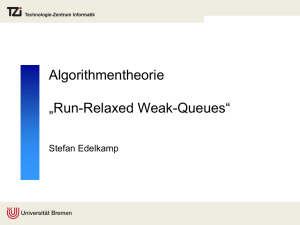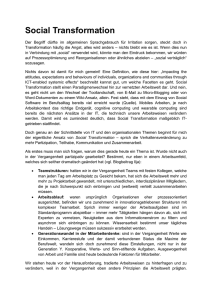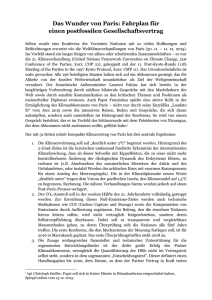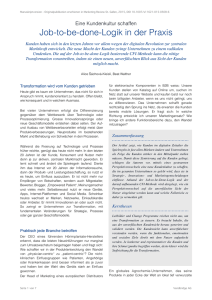AE-RunRelaxedWeakQue..
Werbung
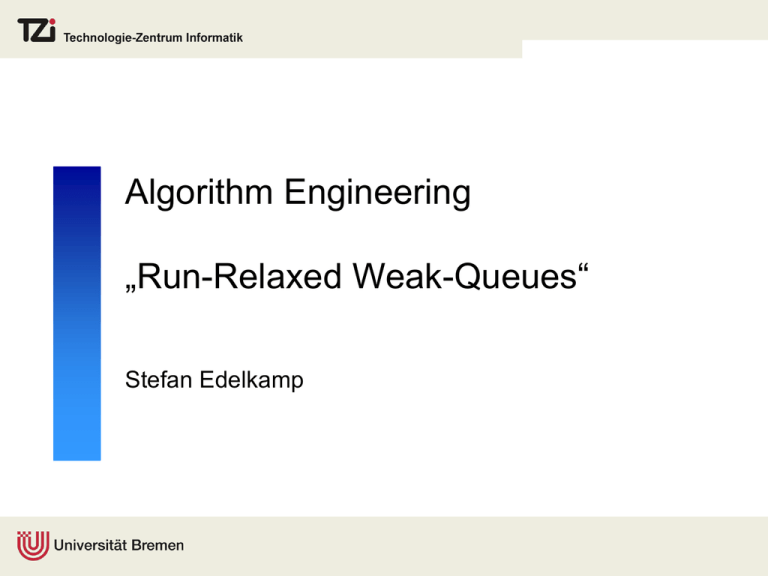
Algorithm Engineering
„Run-Relaxed Weak-Queues“
Stefan Edelkamp
Übersicht
Marktanalyse State-of-the-Art
Perfekte Weak-Heaps
Weak Queues
Heap-Speicherstruktur
Knoten-Speicherstruktur
Markierung und Lambda-Relaxierung
Engineering
Datenstruktur Priority Queue
Abstrakter Datentyp mit den Operationen
Insert,
DeleteMin, and
DecreaseKey.
Wir unterscheiden Ganzzahl und allgemeine Gewichte
Für Ganzzahlen nehmen wir an dass der Unterschied zwischen
dem größten und kleinstem Schlüssel kleiner-gleich C ist
Für Dijkstra entspricht das w(e) = {1,…,C}
Alle
Priority Queue
Operationen
im Bild
Verschiedene
Ansätze
Marktanalyse
Run Relaxed Weak Queues
Alternative zu Run-Relaxed Heaps:
Einfacher zu programmieren
Asymptotisch äquivalent zu Run-Relaxed Heaps
Niedrige konstante Faktoren
delete benötigt 3 log n+O(1) Vergleiche
kann zu log n+O(log log n) verbessert werden
Wenig Platz
Weniger als 3n+O(log n) extra words;
4n+O(log n) with meld].
Notation
p ist der Stiefvater/elter (surrogate parent) von q.
p ist der wirkliche Vater/Elter (real parent) von r.
Sei s ein Knoten in einem Binärbaum
Jeder Vorgänger von s der ein wirklicher Vater/Elter
Eines anderen Vorgänger einen wirklichen Vorgänger
(grandparent, real ancestor) von s.
Perfekte Weak-Heaps
Ein perfekter Weak-Heap ist ein Binärer Baum mit den
folgenden 3 Eigenschaften:
Die Wurzel hat keinen linken Teilbaum
Der rechte Teilbaum der Wurzel ist ein kompletter
Binärbaum
Für jeden Knoten s, ist das Element an s nicht kleiner als
das Element an dem ersten wirklichen Vorgänger von s
(grandparent)
Beobachtungen
1. Ein perfekter Weak-Heap speichert 2^h viele Elemente mit
h ≥ 0.
2. Die Wurzel eines Perfekten Weak-Heaps muss das
minimale Element speichern.
3. Es gibt eine 1-zu-1 Abbildung von Heap-geordneten
Binomialbäumen zu perfekten Weak-Heaps
Weak-Queues
Joining/Merging and Splitting
Heap-Speicherstruktur (heap store)
Ein “heap store” ist
eine Sequenz von
perfekten Weak-Heaps
In aufsteigender
Anordnung ihrer
Größe
Lazy Injection
Heap-Einfügungen (injections) werden relaxiert (lazy)
durchgeführt, wobei nicht jede Join-Operation direkt
ausgeführt wird.
Dabei erlauben wir zwischen 0 und 2 perfekte Weak-Heaps
jeder Größe.
Ziel: Alle Heap-Speicher Operationen “inject”, “eject”, und
“replace” brauchen O(1) worst-case Zeit.
Reguläre rank-Sequenzen
The rank-Sequenz (r0,..,rk) 2 isr regulär, falls jeder Ziffer 2
von eine 0 vorangeht, mit möglichen 1en in dazwischen
Jede Teilsequenz der Form(0 1^l 2) wird “Block” genannt.
Damit muss jede 2 Teil eines Blocks sein, nicht aber 1en
und 0en
Bsp. Die Sequenz (1011202012) beinhaltet 3 Blöcke
Bei Einfügung werden die ersten zwei 1en gleicher Größe
verbunden (join). Für konstanten Zugriff verwaltet ein “join
schedule” alle noch ausstehenden joins als Paare mit
Zeigern zu den perfekten Weak Heaps
Knotenspeicher
Die wichtigste Aufgabe des Knotenspeichers (node store) ist es,
die Weak-Heap Bedingung potentiell verletzenden Knoten
(potential violation nodes) zu verwalten
Diese werden je nach Operation mit Typinformation (unmarked,
member, leader, singleton) markiert und unmarkiert
Die zweit-wichtigste Aufgabe des Knotenspeichers ist es, die
Höhen und Typen zu speichern (mitunter kann diese Information
auch direkt an den Knoten gespeichert werden)
Dazu gibt (in der Originalimplementation) einen Zeiger von dem
Knoten in der Weak-Queue zu dem Knotenelement in dem
Speicher und vice versa
Knotenspeicher-Operationen
Ziel: Die
Knotenspeicher
Operationen
mark, unmark, und
reduce
benötigen O(1) Zeit
im worst-case.
Terminologie
Knotenspeicher
Primitive und komplexe Operation
für „Reduce“
Cleaning Transformation
Parent Transformation
Sibling Transformation
Pair Transformation
Werden als Primitive zu einer
Leader-Transformation
Singleton-Transformation
Zusammengestellt, die in den PQ-Operationen benutzt wird
Cleaning Transformation a)
Parent Transformation b)
Sibling Transformation c)
Pair Transformation d)
Singleton Transformation
two marked nodes q and s do not have the same parent and that
they are of the same height
q and s are the right children of their respective parents p and r,
which both are unmarked.
1. subheaps rooted at p and r are split.
2. the produced subheaps rooted at p and r are joined and the
resulting subheap is put in the place of the subheap originally
rooted at p or r, depending on which becomes the root of the
resulting subheap.
3. two remaining subheaps rooted at q and s are joined and the
resulting subheap is put in the place of the subheap originally
rooted at p or r, depending on which is still unoccupied after the
second step. If after the third step q or s becomes a root, the
node is unmarked.
By this transformation at least one marked node is eliminated.
Run Transformation
Idea: purpose of a run transformation is to move the two
top-most marked nodes of a run upwards and at the same
time remove at least one marking.
Assume now that q is the leader of a run taken from the
leader-object list and that r is the first member of that run.
There are two cases depending on the position of q.
Case 1. q is a right child.
Case 2. q is a left child.
Case 1
Apply the parent transformation to q.
If the number of marked nodes decreased, stop. Now the
parent of r is unmarked.
If the sibling of r is marked, apply the sibling transformation
to r and its sibling, and stop.
Thereafter, apply the parent transformation once or twice to
r to reduce the number of marked nodes.
Case 2
If the sibling of q is marked, apply the sibling transformation
to q and its sibling, and stop.
Otherwise, apply the cleaning transformation to q, thereby
making it a right child.
Now the parent of r is unmarked.
If the sibling of r is marked, apply the sibling transformation
to r and its sibling, and stop.
Otherwise, apply the cleaning transformation followed by
the parent transformation to r.
Now q and r are marked siblings with an unmarked parent;
apply the sibling transformation to them to reduce the
number of marked nodes.
Procedur reduce (leader transform)
Prozedur reduce (singleton transform)
Insert(e)
Decrease(p,e)
Delete(p)
Meld(Q,R)
Implementierung / Engineering
Rasmussen (2008) bietet im Technischen Report eine
Implementierung an, die
eine worst-case Schranke nicht genau trifft (heap store)
Halb so schnell ist wie die von Fibonacci-Heaps in LEDA
Fehlerhaft ist, eine beliebige Folge von insert, delete und
deleteMins führt
Wir (unveröffentlich)
beheben die Fehler von Rasmussen
Doppelt so schnell wie Fibonacci-Heaps in LEDA
relaxieren reduce von O(1) worst-case zu O(1) amortisiert
Gewinnen Speicher (ein Pointer)
Neues reduce
Neues Reduce (ctd.)
Beobachtung
Durch while-Schleife, neuem Cut und Umordnung des
Codes als Invariante:
Weniger als 2 „leader“ und „chairmen“
Bitvektorimplementierung anstatt STL-Listen
Implementierung mit Splice-Kommando
Problem: Finden des höchst-signifikanten Bits
Berechnung des Höchst-Signifikant Bits
According to graphics.stanford.edu~/seander/bithacks.html there
are some alternative options to quickly compute the most
signicant bit in an unsigned int x,mostly based on considering x &
-x.
Options to identify the position of the bit in the result include
converting it to a oat, a modulo computation, or a multiplication.
We experimented with the latter and got slightly better results
than with the 64K table with 65,536 entries denoting the most
signicant bit of all 16-bit numbers
The best option, however, is to use new processor technology,
e.g. in the Barcelona AMD chips processors, which features the
LZCNT command of SSE4a. In GCC (version 4.3 and later) there
are aggressive optimization ags like -mtune=amdfam10 that allow
to exploit its usage
Resultate
